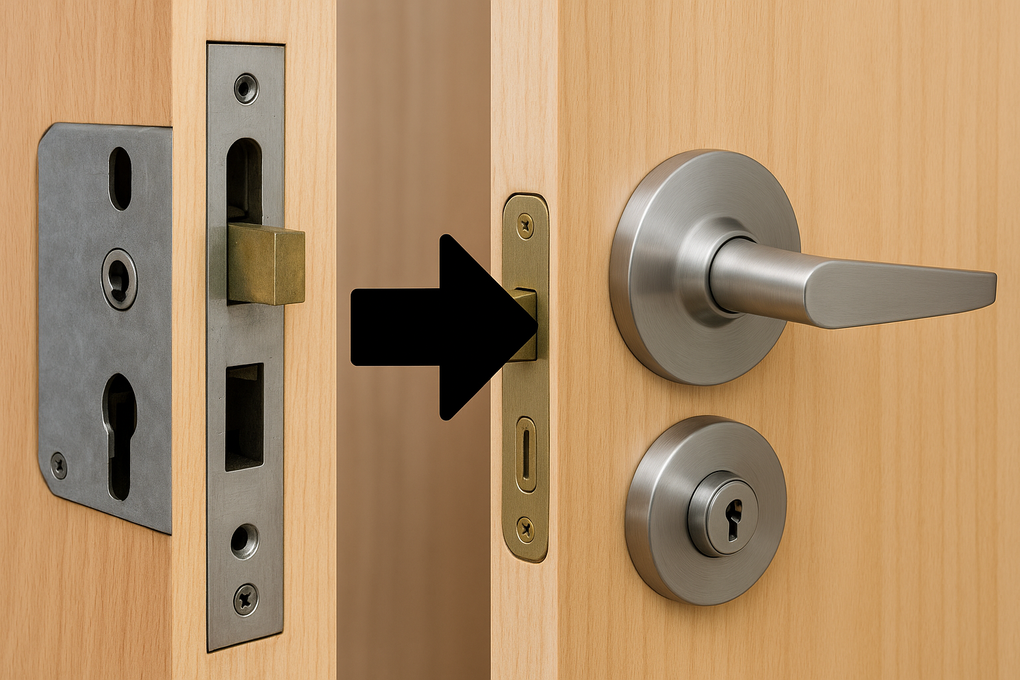
Can You Replace a Mortise Lock with a Cylindrical Lock?
Posted by National Lock Supply on Oct 9th 2025
If you live in a home built before the 1970s, think brownstones, row houses, or early ranches, your exterior door probably still has a mortise lock, a solid, box-shaped mechanism that slides into a pocket in the edge of the door. In contrast, most modern doors use cylindrical locks, the round, easier-to-install style you see on shelves at any big-box store. So when it’s time to remodel or upgrade security, many homeowners ask: can you replace a mortise lock with a cylindrical lock?
Technically, yes, you can. But it’s not a simple swap. Replacing a mortise lock with a cylindrical one involves woodworking, patching, and precise drilling, and in many cases it actually lowers the door’s overall strength. For most homes, upgrading the mortise lock is a better and longer-lasting investment than converting to a cylindrical format.
The Short Answer
A mortise-to-cylindrical conversion is possible, but you’ll need to fill the large rectangular cavity, create new round bores, and often hide old openings with wrap plates or new trim. Unless you’re refinishing the door, the evidence usually shows. More importantly, you lose the solid “steel gearbox” feel that mortise locks are known for. Mortise mechanisms distribute force along the door edge and are usually built to higher ANSI/BHMA grades than most standard cylindrical sets. If security, durability, and appearance matter, keeping the mortise system—and simply modernizing it—is almost always the smarter move.
When Replacing Makes Sense
There are situations where replacing a mortise lock with a cylindrical lock is reasonable. If the existing mortise case is cracked, stripped, or obsolete, and replacement parts are expensive or unavailable, conversion can be practical. It also makes sense if you want a specific style or smart lock that only exists in a cylindrical format, or if you’re refinishing or replacing the door anyway—since patching the mortise cavity becomes part of the overall work. On interior doors, where high security isn’t essential, homeowners sometimes choose cylindrical locks purely for design consistency.
How to Replace a Mortise Lock with a Cylindrical Lock (Step-by-Step)
If you’re planning to replace an older mortise lock with a cylindrical lock, you can absolutely do it, but it’s a moderate carpentry project, not a simple hardware swap. It requires careful measurements, patching the mortise cavity, drilling new holes, and properly aligning your new lockset. Below is a step-by-step guide to help you understand what’s involved before you start.
1. Remove the Old Mortise Lock
Start by taking off the interior and exterior trim (the plates and handles), then remove the spindle and the mortise cylinder if it has one.
Next, unscrew the faceplate on the edge of the door and slide out the mortise lock body. Keep the screws and parts organized—you might reuse some of them for reference later.
Tip: Take a picture of the setup before removing it. It’ll help if you ever need to reinstall or upgrade the same style of mortise lock later.
2. Inspect and Measure the Door
Check the door thickness (most are 1-3/4” or 1-3/8”) and make sure it’s compatible with your new cylindrical lock.
Inspect the area around the mortise pocket for cracks or soft spots. If the wood is weak, you’ll need to strengthen it before installing a new latch.
3. Fill the Mortise Pocket
Because the mortise cavity is much larger than a cylindrical latch, you’ll have to fill that rectangular hole to create a solid surface again.
Cut a hardwood block to fit snugly into the cavity. Apply wood glue along the sides, tap it in until it’s flush or slightly proud, and clamp it until the glue dries.
Once it’s cured, sand or plane it smooth with the door edge. This gives you a strong foundation for drilling the new holes.
If the mortise cavity is uneven, use a structural wood epoxy instead of solid wood—it’s easier to mold and sand.
4. Mark the New Hole Locations
Decide where the new lock should sit. Measure 36" to 38" from the floor to mark the handle height (or match the other doors in your home).
Then choose your backset—most cylindrical locks use 2-3/8" or 2-3/4".
Use the template included with the lockset or a boring jig to mark the centers for your holes.
5. Drill the New Holes
Use a 2-1/8" hole saw to drill the main hole through the face of the door.
Drill halfway from each side to prevent wood tear-out.
Next, use a 1" spade bit or auger bit to drill the edge bore for the latch.
These holes must line up perfectly, so take your time and keep the drill square to the door.
6. Chisel for the Latch Faceplate
Insert the latch bolt into the new 1" hole and trace its faceplate outline.
Use a sharp chisel to cut a shallow recess (mortise) so the latch plate sits flush with the edge of the door when screwed in.
7. Install the New Lockset
Slide in the latch and fasten it with screws.
Then install the interior and exterior knobs or levers through the 2-1/8" bore and secure them per the manufacturer’s instructions.
If your old mortise area still shows, you can use a conversion plate (wrap plate) to cover it neatly and reinforce the door edge.
8. Install the Strike Plate
Close the door and mark where the latch contacts the door frame.
Chisel a new recess on the jamb for the strike plate, then fasten it with 2½" to 3" screws that reach into the wall stud for strength.
If the old mortise strike location no longer aligns, fill that area with wood and finish as needed.
9. Finish, Test, and Adjust
Sand and touch up the door edge if you filled or refinished any areas.
Test the handle and key for smooth operation.
If the latch binds or drags, adjust alignment slightly by repositioning the strike plate.
When It’s Better to Stay Mortise
For main entries, historic doors, or any opening exposed to the weather, a conversion is usually a downgrade. Mortise locks provide heavier boltwork, stronger through-bolting, and smoother operation over decades of use. Re-boring holes in a fire-rated or multifamily door can void its certification, and altering vintage wood doors often leaves visible repairs. If your door is narrow or has a glass panel near the handle, there may not even be enough material for the new cylindrical bores. In those cases, upgrading the existing mortise system is safer and more cost-effective.
What a Conversion Involves
Changing from mortise to cylindrical isn’t just unscrewing one lock and screwing in another. The mortise cavity must be filled with a solid wood insert or epoxy and sanded flush to restore edge strength. New 2-1/8" and 1" holes are then drilled precisely, typically using a jig to avoid misalignment. The new latch and strike must be mortised in different positions, and cover plates may be needed to hide the old faceplate area. For painted doors, this can look clean; for stained or historic ones, it’s rarely seamless. That’s why most locksmiths recommend leaving exterior conversions to a professional who can combine carpentry and hardware skills.
Better Alternatives to Conversion
If your goal is modern function or a style refresh, there are easier, stronger ways to get there.
You can upgrade to a new mortise lockset that fits the existing cutout, combining modern design with proven strength. Current models include everything from classic brass to minimalist black finishes, and even smart-ready mortise trim that adds keypad or app control while keeping the same mortise body. In many cases, simply replacing the mortise cylinder with a high-security version (featuring drill and pick resistance) dramatically boosts protection without touching the door’s structure.
Explore these options at National Lock Supply, where you’ll find a full range of mortise locks, cylinders, and electronic trims that match both historic and modern homes.
Summary
You can replace a mortise lock with a cylindrical lock, but it’s rarely the best value once you factor in carpentry, finishing, and reduced security. Mortise locks were built for strength and longevity, and upgrading within that same system typically costs the same—or less—than converting.
If you want your entry to feel solid, operate smoothly, and look intentional rather than patched, invest in a modern mortise set or smart trim instead of cutting new holes.
Upgrade once, upgrade right—explore high-quality mortise locks at National Lock Supply and give your door the durability and design it deserves.
 SAME DAY & EXPEDITED SHIPPING AVAILABLE
SAME DAY & EXPEDITED SHIPPING AVAILABLE





